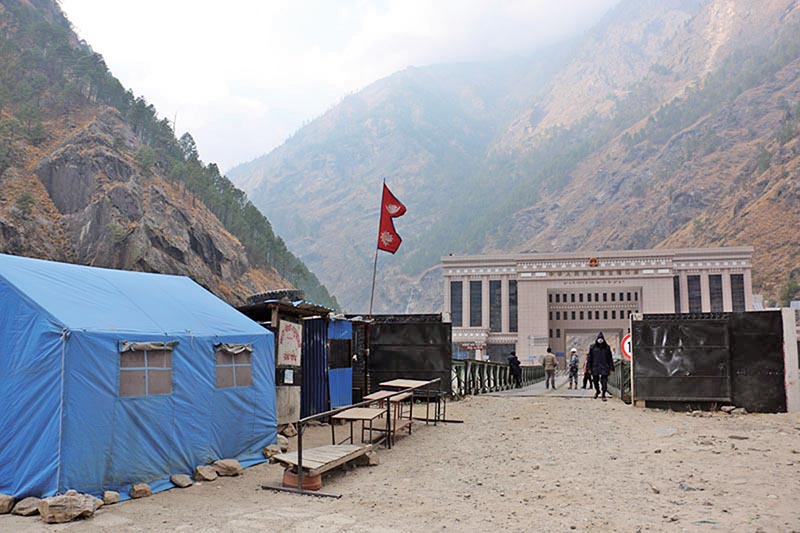The Rasuwagadhi-Kerung border is a vital and strategic gateway between Nepal and China, facilitating trade, tourism, and cultural exchange. This border crossing is not just a physical checkpoint—it is a symbol of Nepal's growing ties with China and an opportunity for economic growth and regional connectivity.
In this blog, we will explore everything about the Rasuwagadhi-Kerung border: its significance, history, transportation routes, and its role in the Belt and Road Initiative. So, let’s take a deep dive into this border's remarkable importance and the opportunities it brings for both Nepal and China.
What is Rasuwagadhi-Kerung Border?

The Rasuwagadhi-Kerung border is located in the northern part of Nepal, connecting the country to Tibet (an autonomous region of China). This land route links Rasuwagadhi, a small town in Nepal’s Rasuwa district, with Kerung (also called Kyirong) in Tibet.
This crossing is one of the main trade routes between Nepal and China, and it has gained increased importance after Nepal signed the Belt and Road Initiative (BRI) with China in 2017. The border crossing is used not only for trade but also for the movement of people, goods, and services.
Key Facts:
- Location: Rasuwagadhi (Nepal) to Kerung (Tibet, China)
- Type of Border: Land border
- Importance: Trade, tourism, and connectivity
- Initiative: Part of China’s Belt and Road Initiative (BRI)
Historical Significance of Rasuwagadhi-Kerung Border
The Rasuwagadhi-Kerung border has a deep historical significance. For centuries, this route has been an important trade and cultural link between Nepal and Tibet. Before the modern road was built, traders used the rugged mountain paths to transport goods such as salt, wool, and other commodities.
In the 21st century, the Rasuwagadhi-Kerung border crossing became crucial for economic and geopolitical cooperation between Nepal and China. The opening of the Rasuwagadhi-Kerung road in 2017 made it easier for both nations to trade goods, thus strengthening their diplomatic and economic ties.
Key Milestones:
- Ancient Trade Route: Historically important for trade between Nepal and Tibet.
- Modern Road Construction: The road was officially opened in 2017, improving connectivity.
- China-Nepal Agreement: A vital part of Nepal's participation in the Belt and Road Initiative (BRI).
Rasuwagadhi-Kerung: Strategic Trade Route
The Rasuwagadhi-Kerung border has immense significance for Nepal in terms of international trade. Here are some reasons why it stands out:
1. Improved Trade with China:
With the opening of the Rasuwagadhi-Kerung road, Nepal has enhanced its trade relations with China. Goods such as electronics, machinery, textiles, and pharmaceuticals are transported more efficiently between the two countries.
2. Access to Global Markets:
Through this border, Nepal gains access to the Chinese market and the broader Asian market, expanding the possibilities for Nepalese exports like agriculture products, handicrafts, and textiles.
3. Development of Infrastructure:
The development of infrastructure like roads, bridges, and customs offices at Rasuwagadhi and Kerung is helping both countries foster stronger economic connectivity. This infrastructure is also important for tourism and cultural exchange.
4. Tourism Opportunities:
The Rasuwagadhi-Kerung border has opened up opportunities for Nepalese tourism. Tourists can travel easily from Nepal to Tibet, visiting stunning sites like the Mount Everest base camp and the Potala Palace in Lhasa. This has made Nepal a potential gateway to Tibetan tourism.
The Belt and Road Initiative (BRI) and Rasuwagadhi-Kerung
The Belt and Road Initiative (BRI), launched by China, is an ambitious plan to enhance global trade through improved infrastructure and connectivity. Nepal's participation in the BRI has opened up new possibilities, and the Rasuwagadhi-Kerung border is a key pillar in this development.
As part of the BRI, Nepal is building new roads, railways, and energy projects, all of which are expected to create more jobs and help uplift local communities in the border regions. With its close proximity to China, this border crossing is set to play a vital role in the regional economy.
BRI Key Benefits for Nepal:
- Better Infrastructure: Road, rail, and air transport improvements.
- Job Creation: Employment opportunities for local populations.
- Economic Growth: Increased trade leading to higher GDP growth.
Transport Routes Across Rasuwagadhi-Kerung
The Rasuwagadhi-Kerung border is a crucial transport route for both countries. The main road from Rasuwagadhi leads to Kerung, where travelers and traders cross customs and immigration before entering Tibet.
Road Transport:
The road infrastructure connecting Rasuwagadhi to Kerung is well-developed, making the movement of goods faster and more efficient. The road is open year-round, with minimal disruption due to seasonal weather.
Rail Connectivity:
There are also future plans to connect Nepal to China by rail, with a proposed railway line running from Kathmandu to Kerung. This would further enhance trade and tourism prospects in the region.
Challenges and Opportunities
While the Rasuwagadhi-Kerung border holds immense promise, it also faces certain challenges:
Challenges:
- Border Security: Ensuring security at the border for the smooth movement of people and goods.
- Weather Conditions: Harsh weather, especially during the winter, can disrupt transport services.
- Environmental Impact: The construction of roads and infrastructure could have adverse environmental effects.
Opportunities:
- Strengthened Bilateral Relations: The border can play a significant role in enhancing Nepal-China relations.
- Boost to Local Economy: Local economies along the border can thrive through trade and tourism.
- Regional Connectivity: The border will serve as a hub for larger regional trade and economic cooperation.
Conclusion: The Future of Rasuwagadhi-Kerung Border
The Rasuwagadhi-Kerung border holds immense potential for Nepal’s future. It promises not only economic growth but also deeper cultural and political ties with China. Through continued infrastructure development, cooperation under the Belt and Road Initiative, and expanded trade and tourism, the Rasuwagadhi-Kerung border can truly become a beacon of prosperity for Nepal.
As Nepal looks towards a future of enhanced connectivity, the Rasuwagadhi-Kerung border is poised to play an instrumental role in the country’s growth on the global stage.





